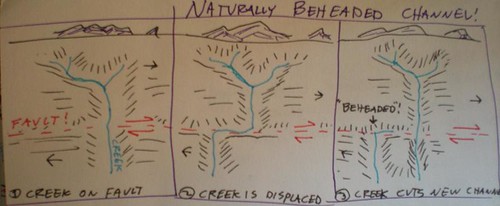There are several ways a channel can be 'beheaded' in nature. A creek can erode into and 'steal' water from another creek, reducing the flow greatly in downstream sections. Action along a fault can also move one part of a creek bed away from another, eventually resulting in the creek abandoning the old channel and creating a new one. The old channel remains but with reduced flow. An image of a creek being offset by a fault in California can be found at this USGS site.
I also drew a diagram. I apologize for the poor quality of this, but I don't have a scanner right now. (I will upload a better version next month). Click on the picture to see a larger version.

In this diagram, you can see how a creek would be 'beheaded' by a fault, causing it to lose the upper portion of its watershed.
Panther Hollow Run once drained a large area of Squirrel Hill, as discussed in previous posts. When Squirrel Hill was developed, most of the water falling on its surfaces was routed into the combined storm drain-sewage system.
Here's another picture I drew (again in rough draft form):

The red lines represent sewer lines. Notice how the upper portion of the creek is intercepted and never flows into Panther Hollow.
It is interesting to note, though, that stormwater that is lucky enough to fall on landscaping (or a rain garden!) and soaks into the ground in Squirrel Hill probably still follows the same route of the historic creek, and emerges via springs in the park. I will look into this more later.
The bad news is this all means that Panther Hollow Run on average probably has much less water in it than it did before Squirrel Hill was built. This means that it is almost dry during hot spells between storms. The good news is that with all the concrete and rooftop area in the old watershed, Panther Hollow would probably be subject to severe flash floods if it were still connected to Squirrel Hill. In the current system, water entering the creek would also be full of sewage during heavy rain overflow events. These are problems faced by Nine Mile Run that are being addressed using erosion control and restoration/construction of wetlands.
If Panther Hollow Run is fully restored, erosion is controlled, and daylighting of Four Mile Run occurs, it may be possible someday to "re-head" some of the Panther Hollow Run watershed, removing this runoff from sewers and creating a more natural creek with more reliable flows.

No comments:
Post a Comment